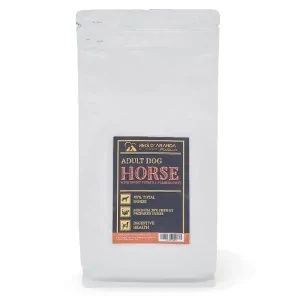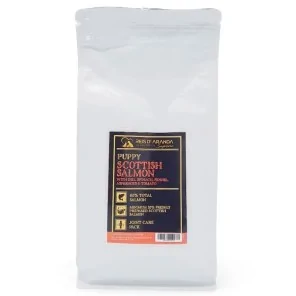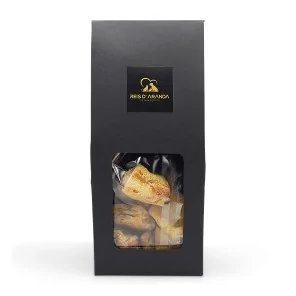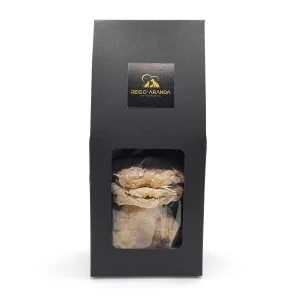Its name says it all: the Vienna blue rabbit comes from Austria. Not only is it beautiful with its shiny blue-grey...
THE FLANDERS CATTLE DOG
INTRODUCTION
Despite its large size (over 40kg), the Flanders Cattle Dog is calm and docile, known to have an obliging nature, and makes a great family pet. The Flanders Cattle Dog can get along well with other animals if raised with them, otherwise some may be aggressive towards other dogs.
THE ORIGIN OF THE FLANDERS CATTLE DOG
There is as yet no concrete documentation concerning the history of the Flanders Bouvier. Theories vary, but what is quite clear is the influence of breeds such as the Mastiff, Barbet and Picard in the creation of this canine species. Among the different theories surrounding the beginnings of this breed, two are the most recognised. Firstly, the descent of these dogs is directly associated with the peat bog dog, a wild animal that managed to be domesticated by humans.
Secondly, and so far the most accepted theory, is the transfer of these dogs to Flanders, Belgium, by the Spaniards during the 16th century. However, the breed as it is known today, resulted from a crossbreeding by the owners of herds in that city in order to combine the characteristics necessary for the protection of their livestock in a single animal. Hence these dogs were used mainly for this purpose: herding flocks. However, their abilities grew. He became an excellent shooting dog, also a high calibre tracker, and nowadays his role as a watchdog is also well recognised in his home town. The first breed standard was published in 1912, accepting different colours and sizes. Later, around 1922, the characteristics of this great friend, also known as ‘Bouvier’, were defined in more detail, although its popularity has not been as great, this breed is highly valued by dog breeders and agricultural workers. Its physical characteristics greatly facilitate the fulfilment of its functions and have also made it a dog that is easy to maintain and prefers a quiet life in the country rather than in the city.
WHAT IS THE FLANDERS CATTLE DOG LIKE?
GENERAL APPEARANCE: This is a compact dog, with a short, stocky body and strong, well muscled limbs. He gives an impression of strength, but without the appearance of heaviness.
In repose, the Bouvier de Flanders should be judged in natural position, without physical contact with the handler.
IMPORTANT PROPORTIONS: The length of the body from point of shoulder to point of buttock should be visibly equal to the height at the withers. The proportions of length of skull to length of muzzle are 3 to 2.
HEAD: Solid in appearance, further accentuated by the beard and tactile hairs. It is in proportion to the body and size of the dog. On palpation its clearly delineated shape is noticeable.
CRANIAL REGION : Well developed and flat, slightly less broad than long. The upper lines of the skull and forehead are parallel. The frontal furrow is hardly marked.
STOP: Not very marked. The raised eyebrows make it more visible than it really is.
FACIAL REGION:
TRUFFLE: The nose ends the forehead in a slightly convex line at its extremity. It should be well developed, rounded at the edges and always black in colour. The nostrils are well open.
HOCIO: Broad, strong, rectilinear in its upper profile. Gradually tapering towards the region of the nose, but never pointed. Its length shall be shorter than that of the skull by a ratio of 2 to 3. Its girth, measured just below the eyes, shall be visibly equal to the length of the head.
BELPHOS: Close fitting and well pigmented.
JAWS / TEETH: Jaws should be strong, of even length. Teeth strong, white, healthy and evenly set. Incisors scissor-shaped or back to back. The dentition should be complete.
CHEEKS: Flat and thin. Zygomatic apophyses slightly protruding.
EYES: Frank and energetic expression, neither prominent nor too deep set in the orbits. They should be slightly oval in shape and set on a horizontal line. The colour should be as dark as possible in relation to the colour of the coat. Light eyes, as well as those with a stray expression should be strongly penalised. The eyelids are black, with no trace of depigmentation.
The conjunctivae should never be visible.
EARS: Cut in a triangle, straight, set on high and highly mobile. It is recommended that the cut be in proportion to the volume of the head.
- NATURAL EARS (NOT CROPPED):
POSITION: Set on high, above eye level. The pinna falls vertically.
SHAPE AND WAY OF WEARING : Semi-long, in the shape of an equilateral triangle, slightly rounded at the tip. They lie flat on the cheeks, except for the slight separation at the upper end of the cartilage. They should not form folds or creases. They should be in proportion to the size of the head and should be covered with satin hair.
NECK: Should be free and sufficiently high. Strong, muscular, gradually increasing towards the shoulder region. Its length is slightly shorter than the head. The nape of the neck is strong and slightly arched. No dewlap present.
BODY: Strong, robust and short.
TOPLINE: The topline of the back and loin is horizontal, taut and firm.
CROSS: Slightly protruding.
BACK: Short, broad, muscular, well defined. Not slack, but supple.
LOIN: Short, broad, muscular. Should be supple, but not flabby in appearance.
Croup: Should follow as closely as possible the horizontal line of the back and merge imperceptibly with the curve of the buttock.
In males it is broad, but not excessively so; in bitches it is more developed. A drooping croup is considered a serious fault.
CHEST: Broad, reaching down to the level of the elbows. It should not be cylindrical. The first ribs are slightly sprung, the other ribs slightly sprung and well laid back, thus imparting the desired length to the chest. Flat ribs shall be heavily penalized.
The distance between the front of the sternum and the last rib should be considerable, i.e. about 7/10 of the height at the withers.
BOTTOM LINE: The underside of the chest rises slightly towards the belly, which is slightly raised. The flanks should be short, especially in males.
TAIL: Set relatively high. It should be in line with the alignment of the spine. Dogs born without a tail cannot be penalized for this. The tail should be docked the same week the dog is born, leaving two or three vertebrae. In countries where tail docking is forbidden, the entire tail is permitted.
LIMBS
FOREQUARTERS:
GENERAL APPEARANCE: Strong boned and well muscled. Seen from the front, they are perfectly straight and parallel.
Shoulders: Relatively long, muscular, not heavy in appearance and moderately oblique. The humerus and shoulder blade are visibly of equal length.
ARMS: Moderately oblique.
ELBOWS: Parallel, close to the body. Detached or sunken elbows when the dog is lying or in action are considered a fault.
FOREARMS: Seen both in profile and from the front, should be perfectly straight, parallel to each other and perpendicular to the ground. Should be muscular and strong boned.
Pasterns: Exactly plumb to the forearm. The pisciform bone alone forms a protuberance on the back of the carpus. The bones are strong.
METACARPUS: Strongly boned, rather short, very slightly sloping towards the front.
HANDS: Short, round and compact. Neither turned in nor turned out. Fingers should be close together and arched. The nails are strong and black. The pads are thick and hard.
HIND LIMBS:
GENERAL APPEARANCE: Powerful, well muscled and well plumbed. Seen from behind, they are perfectly parallel. They should move visibly in the same planes as the forelegs.
Upper thighs: Broad, well muscled. Parallel to the median plane of the body. The thigh bone should be neither too straight nor too sloping. The buttock should be well laid back and firm, forming a breeches.
KNEES: Visibly placed on the imaginary straight line from the highest point of the hip (iliac protuberance). They are perpendicular to the ground.
LEGS: Moderately long, well muscled. Neither too straight nor too sloping.
Hock: Almost touching the ground, broad, well tensed. Seen from behind, straight and perfectly parallel when the dog is at rest.
When the dog is in motion, it should neither turn inwards nor deviate from the axis of the limb.
METATARS: Thick and slender, rather cylindrical. They are perpendicular to the ground when the dog is standing. No dewclaws present.
FEET: Round and solid, with toes close together and arched. Nails strong and black, pads thick and hard.
GAIT / MOVEMENT: On the whole, the Bouvier de Flanders should be sufficiently proportioned to allow a loose, free and lofty movement. Walk and trot are the usual movements, although sometimes dogs with ambling are found. During the usual trot, the Bouvier de Flanders covers himself.
SKIN: Well attached to the body, without excessive flabbiness. The rims of the eyelids and lips are always very dark.
COAT
HAIR CHARACTERISTICS : The coat is very dense. The top coat and the undercoat form a protective layer which is perfectly adapted to the abrupt climatic variations of the region of origin of the breed. The coat should be harsh to the touch, dry and matt, neither too long nor too short (about 6 cm). It is slightly shaggy but never shaggy or curly. On the head it is shorter, and somewhat sparse on the outer part of the ears, the inner pinna of which is protected by moderately long hair. The upper lip is covered with abundant tactile hairs and the chin is covered with a bushy beard which gives the dog that sullen expression so characteristic of the breed. The eyebrows have raised hairs accentuating the shape of the brow arches without covering the eyes. The hair covering the upper part of the back is particularly harsh and bristly. It is slightly shorter on the limbs, but always harsh.
Smooth hair should be avoided as this denotes the absence of an undercoat. The undercoat is made up of a bundle of fine, close lying hairs which grow under the surface coat, thus forming a waterproof coat.
COLOUR: The coat of the Bouvier de Flanders is generally grey, mottled or charcoal. The black brindle coat is also permitted, although it is not favoured. Light colours, called faded, are not permitted. A white star on the forechest is acceptable.
SIZE AND WEIGHT:
HEIGHT AT WITHERS:
- Males: 62 to 68 cm
- Bitches: 59 to 65 cm e
With a tolerance of approximately 1 cm.
For each sex the ideal size is the average of these two limits, i.e. 65 cm for males and 62 cm for females.
WEIGHT:
- Males: 30 to 40 kg
- Bitches: 27 to 35 kg
FAULTS: Any departure from the foregoing points should be considered a fault and the seriousness with which the fault should be regarded should be in exact proportion to its degree and its effect upon the health and welfare of the dog.
SERIOUS FAULTS:
- Fearful dog.
- Molosser in appearance, too heavy.
- Body visibly too long (a slight tolerance for bitches), or too light.
- Head too massive, nasolabial depression too marked, frontal furrow too marked, zygomatic processes too apparent.
- Skull bulging, narrow. Occipital crest too apparent.
- Considerable lack of parallelism between skull and forehead.
- Muzzle too long, nose tucked up.
- Loose, thick lips.
- Mandible with cross occlusion, malocclusion.
- Small, damaged, irregular teeth.
- Complete ears folded or creased.
- Neck cylindrical, dewlap.
- Back sunken or very convex.
- Silky coat, absence of an undercoat, lumpy, glossy, groomed coat.
- Lack of head furnishing.
- Convergent lack of depigmentation (nose, lips, eyelids).
DISQUALIFYING FAULTS:
- Aggressiveness or extreme shyness.
- Any dog showing clear signs of physical or behavioural abnormalities.
- Obvious lack of type.
- Nose with patches of depigmentation or colour other than black.
- Pointed muzzle.
- Markedly overshot or undershot mouth.
- Lack of a tooth other than a PM1.
- Eyes of a different colour or with a misplaced expression.
- Entropion, ectropion, patches of different colour on the eyelids.
- Chocolate brown, white, salt and pepper, discoloured coat. Any other blond colour ranging from light to red, even charcoal.
- Size deviating from the limits of the standard.
N.B.:
- Males should have two apparently normal appearing testicles fully descended into the scrotum.
- Only functionally and clinically healthy dogs of typical breed conformation should be used for breeding.
PERSONALITY: These dogs are intelligent, energetic and with a stable temperament. Because of their past as multi-purpose dogs on Belgian farms, they tend to be excellent guardians and protectors, but need companionship much of the day.
They tend to be reserved with strangers and can be aggressive with dogs of the same sex. However, with proper socialisation, they can become excellent pets and get along well with people, dogs and other animals. It is important to start socialising these dogs while they are still puppies, otherwise they may become aggressive or fearful animals.
HEALTH OF THE FLANDERS CATTLE DOG
Like most large breeds, the Flanders Cattle Dog can suffer from hip and elbow dysplasia. Some dogs may also suffer from eye problems, especially glaucoma.
It is a hardy dog that needs space, exercise and walks with its owners. Ideally, it should be able to roam freely in a garden, as it can withstand both low temperatures and summer heat, its coat protecting it in both cases. It is advisable to brush the extensive coat daily and to visit the groomer every one or two months.
CARE OF THE FLANDERS CATTLE DOG
The care of the coat is complicated and requires brushing and combing the dog two to three times a week, as well as manual stripping every three months. Of course, coat care is more intensive for show dogs than for pet dogs, but in general the coat of the Flanders Cattle Dog demands more care than that of other sheep and cattle dogs.
These dogs also require a lot of physical exercise and companionship. They are not dogs that are content with short walks, but need long walks or jogs every day. Care should be taken, however, not to exert them too much when they are still young, as this can damage their joints. They are also not dogs to be left isolated in the garden, but should spend most of their time with their families. Thus, they may be able to adapt to life in flats if they receive sufficient exercise in the open air, but live best in houses with large gardens. Without constant stimulation and proper obedience training, they may become bored.
In addition to high intelligence, Flanders Cattle Dogs have an excellent memory, so they will surprise more than one with their cognitive abilities. When properly trained, these dogs are true gems of the animal world, as they learn very quickly. They respond well to different training techniques, but it is through clicker training that the most striking and long-lasting results can be obtained.
These dogs can develop behavioural problems when they do not receive sufficient exercise, the attention they demand or the training they need. In such cases, they can become destructive, aggressive or timid dogs. However, when properly cared for and trained, they make excellent pets and are not to be envied by other breeds.
CONCLUSION
The Flanders Mountain Dog is a balanced, affectionate dog with a markedly protective demeanour. It is a working dog with characteristic robustness, intelligence and a portion of self-confidence. Calm, docile and attentive, he is the ideal companion for people with a canine sense. As a watchdog and family dog, he takes his place in the human pack. Courageous and sometimes stubborn, he wants to be trained consistently.
Leave a comment
Log in to post comments
















